Creating a beautiful, fragrant garden of your dreams is not difficult, knowing how to plant roses. These flowers live for about 20 years, but with the right place to plant and good care, this time can increase by 10 times.
Material Content:
When is it best to plant roses in open ground
A rose with a closed root system can be planted throughout the warm season, from spring to late autumn. She perfectly takes root in a new place. It is important to consider the characteristics of planting at different times of the year. In the spring, careful care of the young plant will be required - watering, feeding, pruning, loosening the soil. A rose planted in autumn must be protected before the onset of cold weather with an air-dry shelter.
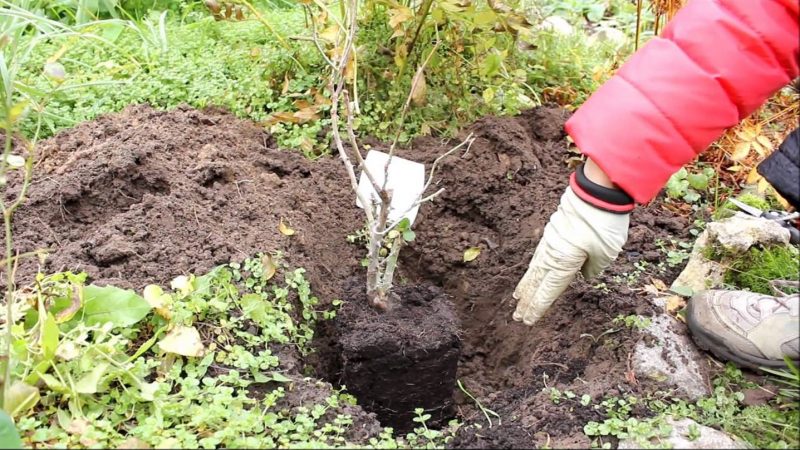
If you bought a seedling with open roots, it is advisable to plant it in the spring.
The soil should warm up to 10 ° C, and night frosts will give way to stable warming.
How to choose material for planting
Selecting planting material, take into account the goals of creating a flower garden. For gazebo or hedge in the garden, climbing roses are suitable, for the rosary - tea roses. A huge variety of old and modern varieties of roses allows you to pick up something really beautiful, suitable for your garden.

Beautiful varieties of roses:
- Pierre de Ronsard - cream flowers with a pink tint, especially noticeable in the center, bush compact from 1.5 to 3 m tall;
- Peace - yellow flowers with a pink edge of a beautiful shape are located 1 on the stem, the bush is vigorous, resistant to disease and frost;
- Golden Celebration - huge flowers, up to 16 cm in diameter, bright yellow with peach or pink edges;
- Chippendale - bright orange densely double flowers, with a strong aroma, plentiful repeated blooming;
- Princess Alexandra of Kent - rich pink flowers with a strong aroma, bush height up to 1 m;
- Lady of Shalott - the variety is resistant to diseases and frosts, large flowers, golden salmon, with tea aroma, large bush, with drooping shoots;
- Jubile du Prince de Monaco - white rose petals with a red edging look very impressive, the bush is compact, up to 0.8 m high;
- Westerland - flowers are orange, large with a strong pleasant aroma, bloom early and bloom until late autumn, bushes up to 2 m high;
- Double Delight - bright raspberry flowers with white petals in the center of the flower, a hybrid tea variety with a stable, wonderful smell, a bush about a meter high;
- Munstead Wood - large burgundy flowers with large, rich aroma, bush about a meter high, blooms for a long time;
- Artemis - a tall bush strewn with spherical flowers of medium size creamy white.
If you cannot plant roses right away, buy seedlings with a closed root system in containers. It is not possible to see the state of the root system in such plants. You can check how long the cutting has been planted, whether it is firmly rooted, it is better not to buy a freshly transplanted one.
In seedlings with an open root system, the roots should be white on the cut.
If you buy a varietal specimen in a box, carefully inspect it. The buds should be alive, green, but without awakened shoots and leaves, the place of vaccination without traces of beauty. The root, wrapped in oilcloth, should have a weight, not seem too light, withered.
Planting roses with cuttings independently cut from the bush is only possible for experienced gardeners, since most varieties grow well only on a rosehip rootstock.
Choosing a place for planting flowers
Rose bushes prefer a well-lit growing place, but in the bright sun all day they will feel uncomfortable. Therefore, choose a plot of garden, illuminated for about half a day.
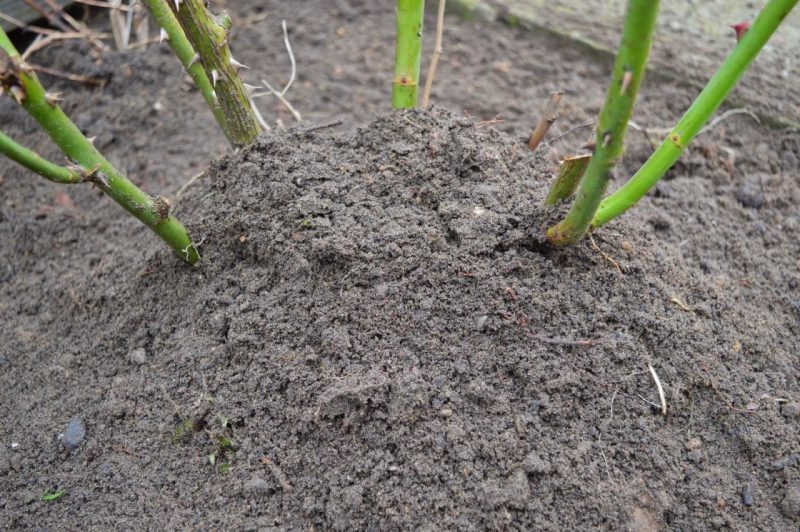
In addition to sunlight, you need fresh, warm air, protection from the wind, fertile soil with good drainage.
Do not plant roses on the north side of the site, in strong shading, on too wet soil. Take into account the depth of groundwater. When they are located close to the surface, an earthen mound is made for roses.
Preparing the soil for planting roses
In order to plant roses in open ground, it will take quite a bit - a shovel, watering can, humus, good ground. If the land on the site is heavy, it is advisable to add sand to it as a baking powder. If sandy soils add turfy soil.
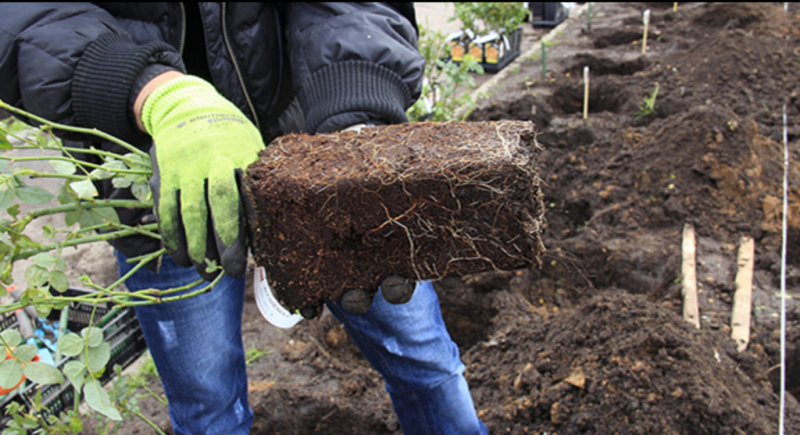
The size of the pit for a flower with a closed root system should correspond to the volume of the container in which it grows. For a rose with an open root system, a hole of 40 cm in diameter and of the same depth is prepared. On a site with clayey, nutrient-poor soil, the hole will need to be made larger to fill it with a fertile, loose substrate.
It will be useful to inquire which plants grew on the selected site before. Bad predecessors are all members of the Rosaceae family. If roses previously grew at a selected location for more than 12 years, the earth must be completely replaced to a depth of 0.5 m.
Soil acidity plays an important role in plant nutrition.
It affects the assimilation of macro- and microelements by the roots. For rose bushes need a slightly acidic soil, on acidic and alkaline, their growth is inhibited.
Check the pH of the soil using a special device or a regular litmus test. If the soil is alkaline, it is necessary to acidify by introducing coniferous humus, horse peat. Acidic soil is calcareous with dolomite or bone meal, wood ash.
Well-rotted compost and leaf humus are also added to the planting pit, mixing everything well with the excavated soil. Spill a hole with water.
A step-by-step guide on how to plant roses of various kinds
Planting roses in the spring has its own characteristics.
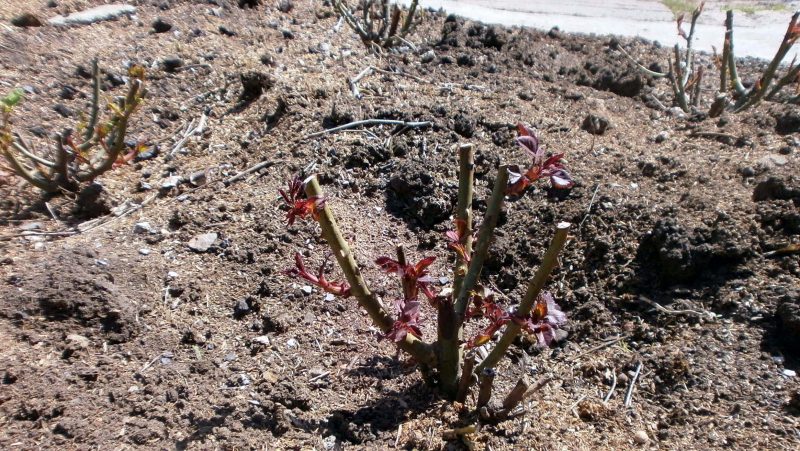
The difference is in pruning the shoots of different species:
- In polyanthus, floribunda and tea-hybrid varieties, shoots are greatly shortened, leaving only 3 buds on them.
- In tall varieties, shoots are shortened by 10 cm.
- Ground cover varieties are not pruned.
- In climbing, park and semi-climbing species, only roots and shoots with damaged tops are shortened.
The grafting site should be buried 3 cm below the soil level, for climbing roses - 8 cm. Then the wild shoots will not break through the thickness of the earth, and young shoots will have their own root system.
A step-by-step description of how to plant roses correctly:
- Choosing a place and preparing the soil, for roses make holes at a distance of about 60 cm from each other. Flowers do not like thickened plantings.
- Seedlings of climbing roses are placed near gratings or other supports at a distance of 1 m.
- All holes are dug in advance, filled with nutritious soil with fertilizers and well watered.
- In a rose with an open root system, roots are cut (1-2 cm). The rose from the box is unwound, and soaked previously in water. The container is simply watered to make it easier to remove the earthen lump from the tank.
- A mound is made in the center of the planting pit, seedling roots are spread evenly over it.
- All roots should look vertically down, must not be allowed to bend.
- A rose is transplanted from the container without disturbing the earthen lump.
- Having fallen asleep a hole, well compact the soil, and watered.
When the water in the hole is slightly absorbed, the flower is spudded to a height of 5 cm to protect the root system. After 2 weeks, the land can be scooped up. After hilling, the seedling needs to be watered again, mulch the soil with peat or sawdust.
A bit about aftercare
Especially careful care is needed for seedlings of roses planted in the spring. They need to be properly trimmed, spud, fertilize, water in time, protect from pests and diseases. After planting, it is advisable to shade roses from the sun. Once a week, it is useful to add any rooting agent to the water for irrigation.
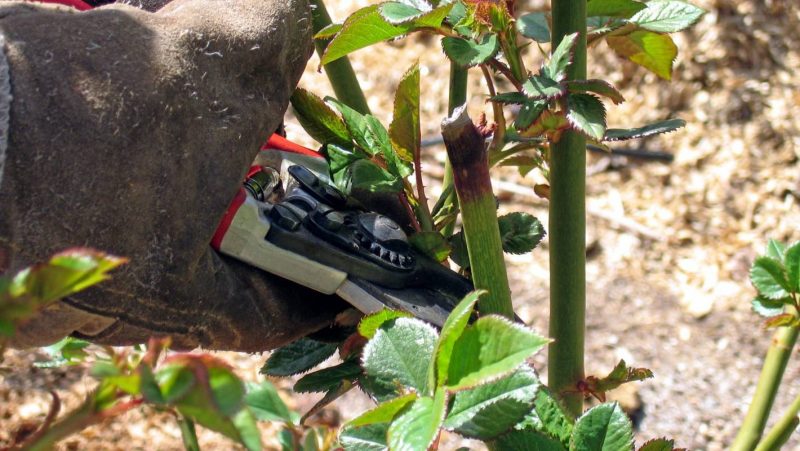
If there are already buds when planting on a rose, it is better to remove them.
Experienced growers sometimes do not do this to see if the variety purchased matches the description. But the plant spends a lot of energy on flowering, so the first year it is desirable to cut off all the buds. You can admire the flowering for 2 years after planting.
Young seedlings are treated as a prophylaxis with a mixture of fungicide and insecticide. In the summer, they monitor the appearance of pests or signs of disease, and immediately take action. If the air is dry, sprinkling is carried out in the summer, watered at least once every 7 days.
Complex fertilizers are applied monthly. From mid-July, they should not contain nitrogen. In September, early October, rose bushes are prepared for winter, pruned, foliage removed, processed, an air-dry shelter built.












